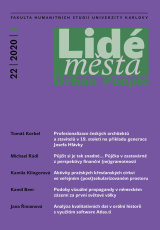Analýza kvalitativních dat v orální historii s využitím software Atlas.ti
DOI:
https://doi.org/10.14712/12128112.2344Klíčová slova:
oral history, grounded theory, qualitative research, ATLAS.tiAbstrakt
This article summarises the current possibilities of using computer technologies for analysis and interpretation in research based on oral history interviews. At least three methodological approaches meet in one place: an oral history method used as a tool to create primary data sources, a method of grounded theory applied as a basic approach to the analysis and interpretation of biographical interviews, and a computer-assisted analysis process performed using ATLAS.ti’s qualitative research software. Computer systems have begun to emerge as a tool for the clearer, more detailed, and more accurate application of traditional methods of qualitative research. However, their wide range of possibilities begin to interfere already in the way the very methods are used. In accordance with the post-structuralist idea that language is not just a tool, but that its influence also has the opposite effect on thinking, especially on the possibility of visualising and interconnecting the individual objects that the researcher can use in software for qualitative analysis, this software transforms the way of working with primary data. Visibility and visual representation are key elements of scientific cognition in general. Our thoughts about data might be visually captured and preserved for future research. The mystery of qualitative research, often described as an extraordinary feeling for the subject of research or intuition, can be captured and visibly recognised in the density of codes and in the density of their connection with other codes and quotations in the sources used.
Stahování
Publikováno
Jak citovat
Číslo
Sekce
Licence
Copyright (c) 2022 Jana Římanová

Tato práce je licencována pod Mezinárodní licencí Creative Commons Attribution 4.0 .


